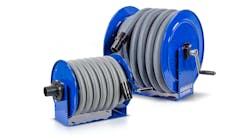In the demanding world of today’s complex fleet maintenance shops, one principle factor is at the core of every successful facility: safety. This is especially true when it comes to lifting heavy duty vehicles.
As a starting point, safety begins with the selection of the proper type of lift. To ensure maximum performance and operational safety, we recommend that all lifts be third-party tested and validated.
Specifically, we strongly support, endorse and recommend that all vehicle lifts be certified by the Automotive Lift Institute (ALI). Certification, as ALI notes, “is a system whereby an independent third-party organization determines that a manufacturer has the ability to produce a product that complies with a specific set of standards. Certification further authorizes the manufacturer to use the controlled label of the third party on listed products representing the certified model.”
In the instance of vehicle lifts, maintenance facilities should insist on products that carry the coveted ALI Gold Label. It signifies that a particular lift model is in electrical and mechanical compliance with established and agreed-upon standards, and in turn, advances the highest quality standards in the lifting industry.
Lift Capacity
Another key factor in lift selection and safety is capacity. Facility managers must know in advance the weight of the heaviest vehicle they intend to lift and make absolutely certain that the lift selected is certified to meet or exceed that capacity.
Similarly, always measure the height clearance of the facility – prior to selecting a lifting system – to ensure ample room to raise a vehicle for servicing. Always note the height of the tallest vehicle you intend to lift and make certain there is sufficient room to raise the vehicle to a proper height that will permit a technician to work comfortably underneath the vehicle.
We also recommend selecting a lifting system that prevents unauthorized access. A locked control box, secure key or a “wand” to operate the lift are several types of features that can ensure greater lift security.
Stability When Lifting
Another key factor to operating a safe lifting system is stability. That’s why we employ a lifting approach in which “synchronization” starts as soon as the lift goes into motion and continues through the full range of travel. In that way, it ensures safe and smooth lifting and lowering cycles, particularly in cases where the vehicle weight distribution is unequal, such as with sweepers, mixers, fire trucks and other emergency vehicles.
Operators can also ensure stability by proper lift positioning. For example, mobile column lifts should only be used on a firm foundation on level ground. If lifting takes place outdoors, technicians must be ever-alert to wind loads. In addition, lift operators should make certain that forks on mobile columns and contact points on inground lifts are properly positioned prior to raising the vehicle.
We also recommend that prior to lifting to maximum height, operators first raise the vehicle 12 inches or less, pause, and then conduct a visual inspection of the entire perimeter of the partially raised vehicle prior to fully lifting the vehicle. This procedure may take a few extra seconds, but it is well worth it for safety’s sake.
Safety Culture
Stertil-Koni also strongly recommends that facility managers consider additional equipment and accessories specifically designed to ensure lift operator safety.
One unsung hero in many fleets is the high lift wheel dolly. It allows proper alignment of a dual tire assembly with the brake drum to the axle tube to be completed efficiently and accurately. It also dramatically lowers the occurrence of back injuries and abdominal strains because wheel removal is completed at an altitude which is higher than floor level and in line with technicians working in a fully standing position.
Other products to consider include the transmission jack and the fork lift adaptor. The latter provides a quick, safe and reliable way to perform wheels-free lifting and forklift servicing that is ergonomically designed with the vehicle and the technician in mind.
Beyond the lifting system selected, creating a permanent, positive culture of safety is also essential to ensuring a safe fleet maintenance facility.
Service bulletins and safety messages should be prominently posted in public places and lift operators should be trained, and re-trained on a regular basis.
Plan for Regular Maintenance
Finally, there is the all-important topic of vehicle lift servicing. Make certain that all lifts are subject to a regular program of planned maintenance in accordance with the manufacturer’s recommended schedule and that each lift in your facility receives an annual lift inspection by an ALI certified lift inspector.
With the launch of the ALI’s Lift Inspector Certification Program in October 2012, it became the first program of its type in North America to independently test and certify vehicle lift inspectors.
In sum, a well-designed, carefully planned approach to safe lifting is essential. It reduces downtime and provides for a safe working environment for today’s busy fleet technicians.



